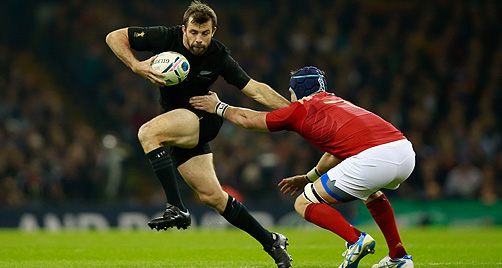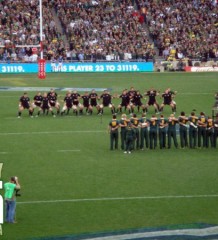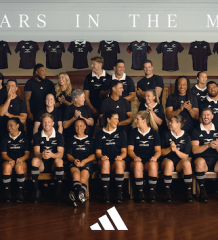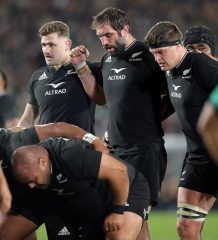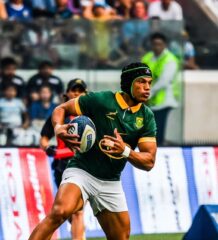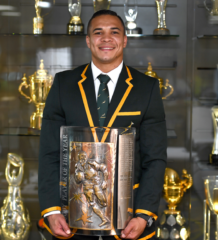2015 All Black retirements – Conrad Smith
Given some of the selection choices at World Cup level over the years, the fact that Smith was able to provide solidity of selection through two successful Cup campaigns is evidence alone of his value.
Remembering the decisions to play Christian Cullen (1999), Leon MacDonald (2003) and Mils Muliaina (2007) away from their preferred positions at centre, New Zealand didn’t have the best reputation for making the most of players of their obvious quality.
But Smith, after suffering a broken leg in New Plymouth with the Hurricanes in 2006, put that and other injury setbacks behind him to provide an assurance in the position that highlighted his undoubted quality.
Not the biggest of players, and certainly having none of the muscle bulk of his long-time midfield partner Ma’a Nonu, Smith still won respect for his defensive play while complementing that with the centre’s usual ability to give a pass to his outsides, to take outside gaps when they were there for the taking and to use his own footwork to great effect.
Clearly identified as a prospective talent he was an All Black in his first season of Investec Super Rugby and that only a year after making his first-class debut for Wellington.
He marked his Test debut against Italy by scoring a try with his first touch of the ball, and his second Test was the outstanding 45-6 win over France in Paris on the same northern tour of 2004.
Once Tana Umaga retired at the end of the 2005 season it seemed the centre position was Smith’s for the taking. But he suffered his broken leg and while he played two games on the end of season tour in 2006, including another 47-3 hammering of France, he played only one Tri Nations game in 2007 and appeared only in pool games at the 2007 World Cup.
But from the 2008 season he never looked back, became a member of the team’s leadership group and formed his durable liaison with Nonu in midfield which saw them play a world record 61 Tests together. The pair of them also managed the rare feat of never playing in a losing World Cup match in their 14 appearances.
Comparisons are always subjective, governed as they are by the laws of the time and by the teams around them. But when talking of select company in the position, who will Conrad Smith always be compared with?
Among older rugby fans a place would always be held on such a list for Johnny Smith.
He played four Tests from 1946-49. His best years were denied him by World War Two and a chance to add to his record was lost when Maori were excluded from consideration for the 1949 tour of South Africa. However, he did tour with the Kiwis in Britain and Europe after the war and all who played with him were convinced of his greatness.
Team-mate Bob Scott said Smith had a superb disguise which almost feigned disinterest in proceedings only to strike like a cobra when opponents least expected it. Scott said Smith was the first example he saw of a thinking footballer.
Bill Davis made his Test debut in New Zealand’s 75th Jubilee Test against Australia at Athletic Park in 1967. That was three years after he toured Britain and France with the All Blacks. But having been exposed to top-level rugby during Hawke’s Bay’s Ranfurly Shield era of the late-1960s, he arrived ready for action and was a key member of Brian Lochore’s world-class side of those years.
He had a great ability to take the outside gap and demonstrated that quality from the outset of his Test career in which he played 11 Tests and 42 matches in all for the All Blacks. Davis scored three Test tries, one in his debut game, one against Wales at Cardiff Arms Park in his third Test and one against Scotland in his fifth Test.
Bruce Robertson appeared in 34 Tests, a significant figure in pre-professional days and appeared in 68 All Blacks games overall after making his debut in 1972. A long-legged centre he had good speed and was one of the finest exponents of putting his wing into try-scoring positions, as the records of Bryan Williams (66 tries in all games for New Zealand) and Grant Batty (45 tries) especially will attest.
He scored four tries in Tests and landed two dropped goals, while he also captained the All Blacks three times in non-Test matches.
Perhaps his finest try wasn’t seen by most of his team-mates. It came at Edinburgh in 1978 right on fulltime as the gloaming had well and truly set in with the darkness making it all but impossible to see the action on the field. But it came after a charge down of an attempted Scots dropped goal and a length of the field kick and chase by the All Blacks with Robertson getting the touchdown that secured New Zealand’s first grand slam.
Joe Stanley was one of the famous Baby Blacks when making his Test debut against France in Christchurch in 1986 while the senior New Zealanders were in South Africa with the Cavaliers. But such was the impression he made that he retained his place when the banned players returned to the Test side.
Having come through with the triumphant Auckland Ranfurly Shield team of the 1980s, Stanley was another example of the centre who was consistently capable of setting up his outsides. With John Kirwan, Terry Wright and Craig Green on the receiving end, the evidence of his worth is plain to see.
Stanley played 27 Tests between his debut and the second Test against Scotland in 1990, while he scored four tries.
Frank Bunce was the player who eventually stepped into Stanley’s boots having followed a remarkably similar late start to his international career. He played for Samoa first, at the 1991 Rugby World Cup, before being included in the All Blacks in 1992.
As Conrad Smith formed a dynamic combination with Ma’a Nonu, so Bunce was united with Walter Little, and like the Wellington pair, Bunce and Little also played together at provincial level for North Harbour. He set a record of 55 Test matches while bridging the amateur and professional eras and in the latter part of his career nurtured the stunning talent that was Jonah Lomu while Jeff Wilson was invariably on the other wing.
Not only was he a fine distributor of the ball but Bunce was also a sound defender who scored 20 Test tries.
Tana Umaga was a later arrival at centre, having played many of his early Test matches on the wing. In his 74-Test career, he played at centre on 42 occasions while he played on the wing 24 times and at second five-eighths seven times.
In comparison, to the other centres on this list he was more of a finisher, possibly as the result of his earlier days on the wing. He scored 36 Test tries which places him seventh on the all-time All Blacks Test try-scoring list.
By the time he retired as captain having led the All Blacks to their second grand slam in Britain, he had developed a reputation as an outstanding centre both on attack and defence.
Related Posts
« 2015 All Blacks retirements – Ma’a Nonu Ieremia to coach Samoa »


